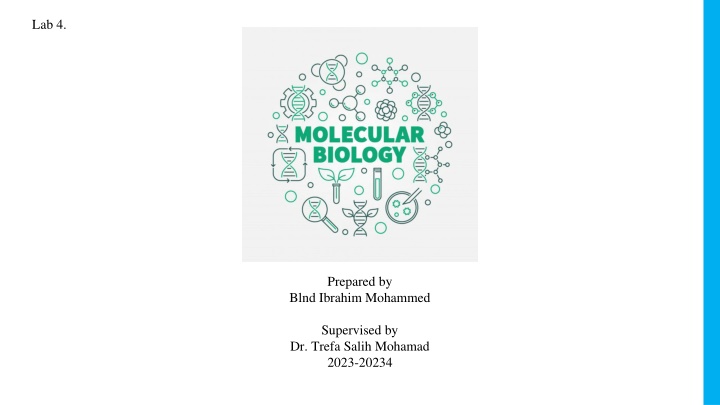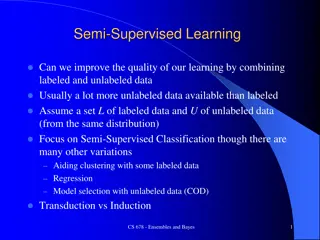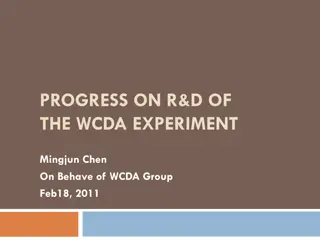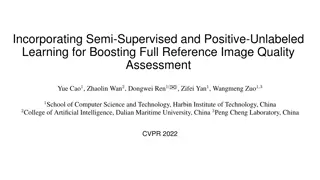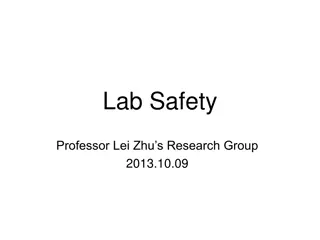Lab Experiment Report by Ibrahim Mohammed, Supervised by Dr. Trefa Salih
This document is a laboratory report prepared by Ibrahim Mohammed and supervised by Dr. Trefa Salih for the year 2023-2024. It likely details the experimentation, analysis, and findings of a scientific investigation conducted within a laboratory setting. The report may include data, observations, conclusions, and recommendations based on the conducted research.
Download Presentation

Please find below an Image/Link to download the presentation.
The content on the website is provided AS IS for your information and personal use only. It may not be sold, licensed, or shared on other websites without obtaining consent from the author.If you encounter any issues during the download, it is possible that the publisher has removed the file from their server.
You are allowed to download the files provided on this website for personal or commercial use, subject to the condition that they are used lawfully. All files are the property of their respective owners.
The content on the website is provided AS IS for your information and personal use only. It may not be sold, licensed, or shared on other websites without obtaining consent from the author.
E N D
Presentation Transcript
Lab 4. Prepared by Blnd Ibrahim Mohammed Supervised by Dr. Trefa Salih Mohamad 2023-20234
DNA EXTRACTION From Human Blood Introduction DNA extraction from human blood is a fundamental and crucial process in molecular biology and genetics research, as well as in various applications such as forensic science, medical diagnostics, and genetic testing. Human blood contains a wealth of genetic information encoded in the form of deoxyribonucleic acid (DNA), which carries the genetic instructions necessary for the development, functioning, and regulation of our bodies. Extracting DNA from blood allows scientists, medical professionals, and forensic experts to study, analyze, and manipulate this genetic material for various purposes.
Blood samples The process of DNA extraction from human blood involves several key steps, beginning with the collection of a blood sample from an individual. This sample can be whole blood, plasma, serum, or specific blood components, depending on the research or diagnostic requirements. 1. Plasma DNA extraction is often used for applications where the focus is on analyzing cfDNA, such as liquid biopsy for cancer detection or prenatal testing for fetal DNA. 2. Serum DNA extraction is used in situations where it is essential to minimize potential inhibitors for downstream molecular biology applications. It is also utilized in research or diagnostics where serum is the preferred sample type. 3. Whole blood DNA extraction is used when the goal is to obtain genomic DNA for applications like genotyping, DNA sequencing, paternity testing, or any other analysis requiring intact genomic DNA.
The basic steps for whole blood DNA extraction 1. Collect Blood Sample: Use appropriate aseptic techniques to collect a blood sample from the individual. Common methods include venipuncture, fingerstick, or other blood collection methods. Collect the blood in a sterile tube containing an anticoagulant (e.g., EDTA) to prevent clotting. 2. Lysis of Blood Cells: Place the buffy coat or whole blood sample into a lysis buffer containing detergents and enzymes that break down cell membranes and proteins. This step releases the genomic DNA from the cell nuclei. The lysate may appear viscous. 3. Protein Precipitation: Add a protein precipitation solution (often containing isopropanol or ethanol) to the lysate. This causes the proteins and other contaminants to precipitate out of the solution. 4. DNA Precipitation: Centrifuge the lysate again at a high speed (typically 10,000-15,000 x g) for several minutes. This separates the genomic DNA from the remaining liquid components, as DNA is less soluble in ethanol or isopropanol. 5. Wash and Pellet DNA: Carefully remove the supernatant (liquid above the DNA pellet) without disturbing the DNA pellet. Wash the DNA pellet with a wash solution (often ethanol), then centrifuge it again briefly to remove any remaining wash solution. 6. DNA Resuspension: Gently resuspend the DNA pellet in a suitable buffer or elution solution to solubilize the DNA. This elution buffer typically contains a low salt concentration to maintain DNA stability. 7. Storage: Store the extracted DNA at an appropriate temperature (-20 C or -80 C) to maintain its integrity for future use.
GeneJET Whole Blood Genomic DNA Purification Mini Kit/procedure 1. Add 20 L of Proteinase K Solution to 200 L of whole blood, then mix by vortexing. 2. Add 200 L of Lysis Solution, then mix thoroughly by pipetting to obtain a uniform suspension. 3. Incubate the sample at 56 C for 10 minutes. 4. Add 200 L of ethanol (96 100%), then mix by pipetting. 5. Transfer the prepared mixture to the spin column, then centrifuge at 10.000RPM for 1 minute. Discard the collection tube containing the flow-through solution. 6. Add 500 L of Wash Buffer WB I (with ethanol added), then centrifuge 10.000RPM for 1 minute. Discard the flow- through. 7. Add 500 L of Wash Buffer II (with ethanol added) to the column, then centrifuge at 10.000RPM for 1 minutes. 8. Discard the collection tube containing the flow-through solution, then transfer the column to a sterile 1.5 mL microcentrifuge tube. 9. Add 200 L of Elution Buffer to the center of the column membrane to elute genomic DNA. Incubate for 5 minutes at room temperature, then centrifuge at 10.000RPM for 1 minute.
Troubleshooting Troubleshooting in whole blood DNA extraction is important to ensure the success of the process and obtain high-quality DNA for downstream applications. Here are some common issues that can arise during whole blood DNA extraction and potential solutions to address them: 1. **Low DNA Yield:** - **Possible Causes:** - Insufficient sample volume. - Incomplete cell lysis. - DNA loss during precipitation or washing steps. - **Solutions:** - Ensure that you start with an adequate volume of blood. - Verify that the lysis step is carried out for the recommended duration and at the correct temperature. - Be careful during precipitation and washing steps to avoid losing DNA. 2. **Contaminants or Inhibitors in DNA Sample:** - **Possible Causes:** - Carryover of proteins, RNA, or other contaminants during DNA extraction. - Presence of PCR inhibitors from incomplete removal of lysis buffer or ethanol. - **Solutions:** - Ensure proper mixing during steps involving lysis buffer and precipitation solutions. - Perform additional wash steps to remove contaminants or inhibitors. 3. **DNA Degradation:** - **Possible Causes:** - Overheating during the lysis step. - Exposure to DNases. - Repeated freeze-thaw cycles of the extracted DNA. - **Solutions:** - Follow the recommended lysis temperature and duration. - Use DNase-free reagents and equipment. - Store DNA at -20 C or -80 C and avoid multiple freeze-thaw cycles. 4. **Visible Contaminants in DNA Sample:** - **Possible Causes:** - Incomplete removal of proteins or cell debris. - **Solutions:** - Ensure proper centrifugation during steps involving precipitation and washing. - Use a clean microcentrifuge tube to collect the DNA pellet after precipitation.
5. **Low DNA Purity:** - **Possible Causes:** - Contamination with RNA or proteins. - **Solutions:** - Use DNA-specific purification columns or methods to improve purity. - Ensure thorough removal of RNA and proteins during the extraction process. 6. **Difficulties in DNA Resuspension:** - **Possible Causes:** - Inadequate elution buffer. - DNA pellet not fully dissolved. - **Solutions:** - Use an appropriate volume of elution buffer for resuspension. - Gently pipette or vortex to ensure complete DNA dissolution. 7. **DNA Shearing:** - **Possible Causes:** - Aggressive pipetting or vortexing. - **Solutions:** - Handle DNA gently during resuspension and subsequent processing steps. 8. **Inconsistent Results:** - **Possible Causes:** - Variability in sample handling or extraction steps. - **Solutions:** - Maintain consistent laboratory practices and follow a standardized protocol. 9. **Kit-Specific Issues:** - **Possible Causes:** - Deviations from the manufacturer's protocol. - **Solutions:** - Follow the manufacturer's instructions precisely.
